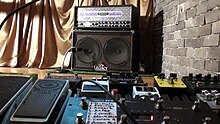
The Mesa/Boogie Rectifier series is a line of guitar amplifiers made by California-based manufacturer Mesa/Boogie. Introduced in 1992, the line's first model was the Dual Rectifier, which is often described as the definitive amp of rock music in the 1990s for how widely it was used by guitarists across multiple rock genres in the decade after its release. Its success led to Mesa/Boogie releasing an extensive line of Rectifier amps.
History
Development
Hard rock and metal guitarists increasingly sought heavier tones by the late 1980s, and many guitar techs, like Michael Soldano and Reinhold Bogner, turned from modifying amps to building their own boutique models to satisfy demand. Faced with this increasing competition, Mesa/Boogie began developing a new, higher-gain model of their own in 1989, dubbed the "Dual Rectifier" in reference to its use of both tube and silicon diode/solid-state power amp rectification. The company first created two distinct prototypes, known as Revisions A and B, before settling on the Revision C circuit for the Dual Rectifier's debut. Mesa/Boogie founder Randall Smith stated that he and the amp's other designers took inspiration from the local Bay Area hot rod scene, especially what Smith observed to be the "harmonics" of pushed V8 engines at a garage next door to the company's headquarters. Smith later described the amp's circuit as "revolutionary," noting that, unlike most other amp models, the Dual Rectifier was not based on an earlier amp design.
Release
Upon its launch in February 1992, Mesa/Boogie initially feared they had brought their amp to market too late, as its initially intended market—hair metal—had been quickly overtaken in popularity by genres like grunge and punk. Their fears proved unfounded, however, as guitarists across a wide swath of rock genres adopted the Dual Rectifier, including artists in grunge (Alice in Chains, Soundgarden), alternative (Foo Fighters, Bush), punk (Bad Religion, Blink-182, Sublime), and metal (Metallica, Tool, Rammstein). The amp became especially associated with the burgeoning nu metal genre and bands like Korn, Limp Bizkit, and Linkin Park.
The original 100-watt, two-channel Dual Rectifier model was produced until 2000, consisting of Revisions C through G, with Revision G being the most commonly-used version and the version responsible for establishing the amp's signature sound. In 2000, Mesa/Boogie switched to a three-channel version of the Dual Rectifier, which has remained in production since.
From 1993 until 2004, the Dual Rectifier represented half of Mesa/Boogie's entire business, greatly exceeding the company's expectations. Given its widespread use among rock guitarists in the 1990s, the Dual Rectifier is often described as the definitive amp of the decade in that genre, while Music Radar went further, writing that it is arguably the most important high-gain guitar amp of all time.
Expansion
The Dual Rectifier's popularity led Mesa/Boogie to develop a family of Rectifier products, including the Triple Rectifier, which does not have three rectifiers but rather features 150 watts of output. Other iterations include the Single Rectifier, Trem-O-Verb, Rect-O-Verb, Maverick, Road King, Roadster, and Badlander models. In 2025, Mesa/Boogie released the "90s Dual Rectifier" model, a reissue of the model based on the specs of the amp's original production run.
Design
The Dual Rectifier was Mesa/Boogie's take on a big, monster-metal head
—notably sporting a metal, diamond-patterned tread plate as a front panel—that was intended to look threatening compared to the brand's earlier Mark series amps. Premier Guitar described the Rectifier's aesthetic as "tough-guy industrial."
The original Dual Rectifier model had 100 watts of output power with two channels and three voicings: Clean, Orange/Crunch, and Red/Distortion. Its use of both tube and silicon diode/solid-state power amp rectification provided players a choice of modern, tight, fast attack (diode) or a smoother, vintage-style attack and sag (tube) via a "Rectifier Select" switch. Other features included a "Bias Select" switch for changing between 6L6 and EL34 power amp tubes, a "Bold/Spongy" switch, and a "Channel Cloning" option that alters the two channels to make them closely resemble each other. Early production models (from 1992 to 1994) had a series effects loop and then a parallel effects loop starting with Revision G in 1994. Revision G became the most widely used version, with Guitar World describing its massive, tight low end, throaty mids and super-saturated gain
as the Dual Rectifier's signature sound. Later three-channel Dual Rectifiers added a dedicated clean channel, as many players had requested, as well as new voicings: Raw, Vintage, or Modern (on both lead channels) and Clean or Pushed (clean channel).
See also
References
- ^ Koe, Crystal. "Are we about to see a new version of the iconic Mesa Boogie Dual Rectifier?". guitar.com. Guitar Magazine. Retrieved 13 January 2025.
- ^ Gill, Chris (3 May 2024). "How the Mesa-Boogie Dual Rectifier defined the high-gain guitar sound of the 1990s". guitarworld.com. Guitar World. Retrieved 13 January 2025.
- ^ Owen, Matt. ""An original icon built by the same artisans who built them 30 years ago": Mesa/Boogie is reviving the Dual Rectifier – the hallowed amp head that defined the sound of 1990s high gain music". guitarworld.com. Guitar World. Retrieved 13 January 2025.
- ^ Horsley, Jonathan. ""There's something about the harmonics of a V8 that's just mind-blowingly badass and powerful sounding": Mesa/Boogie founder Randall Smith on how his high-gain amp designs were influenced by hotrodded muscle cars". musicradar.com. Music Radar. Retrieved 13 January 2025.
- ^ Reiff, Corbin. "Builder Profile: Mesa/Boogie". premierguitar.com. Premier Guitar. Retrieved 13 January 2025.
- Seah, Daniel. "Mesa/Boogie refreshes the Rectifier series with Badlander 100 and 50 tube amps". guitar.com. Guitar Magazine. Retrieved 13 January 2025.
- Zaehringer, Lyle. "Mesa/Boogie 2010 Multi-Watt Dual Rectifier Amp Review". premierguitar.com. Premier Guitar. Retrieved 13 January 2025.
- Marten, Neville (18 September 2009). "Mesa/Boogie Dual Rectifier review". musicradar.com. Music Radar. Retrieved 13 January 2025.